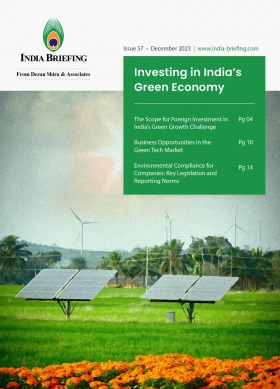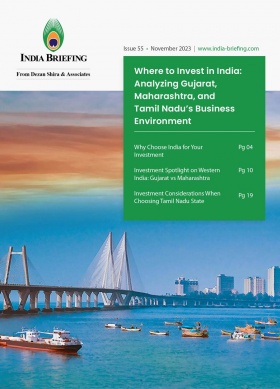India’s Economy in 2023: A Year-End Review
As we near the end of 2023, we recap key developments shaping India’s economy and keeping it poised for rapid growth going into 2024.
Following a successful moon mission and hosting the G20 Summit, India is positioned to emerge from 2023 with increased stability and optimism for its growth and future prospects. The country’s attractiveness as an investment destination remains robust, given the size and scale of operations it has to offer to global companies, abundant skilled talent pool, and prowess in technology and innovation.
The industrial manufacturing sector has experienced a significant boost, attracting global technology giants like Apple eager to expand their supplier networks within India. This momentum is further supported by the implementation of state industrial policies that complement sector-specific incentive schemes. Concurrently, substantial investments in logistics and infrastructure development, including the construction of new roads, highways, and rail tracks, underscore the government’s commitment to bolstering this critical sector.
India’s strategic focus on reducing logistics costs is pivotal for its ambition to become a key player in global supply chains and become a US$5-trillion-economy by the end of 2025. With an eye on the future, the country aims to achieve developed economy status by 2047, demonstrating a clear trajectory towards sustained growth and development.
We discuss India’s performance on key macroeconomic indicators in this year-end review of 2023.
READ: India’s Outlook for 2024-25: Key Growth Areas and Investment Prospects
State of the economy
As the world’s fastest-growing economy for the past two years, India experienced several developments in 2023 that heighten foreign investor confidence.
A Reuters’ report notes that India is now reaching the pivotal phase of the S-curve, characterized by a significant acceleration in urbanization, industrialization, household incomes, and energy consumption. This phase typically spans several decades, marked by rapid growth in these key factors.
Boasting a GDP of US$3.75 trillion, India is the fifth largest economy in the world. The per capita income, per government data, was INR 98,374 in 2022-23 (approx. US$1,183). Further, Reserve Bank of India (RBI) Deputy Governor Michael D Patra told media last month that the Indian economy was on track to hit US$5 trillion by 2027 on the back of developments in the financial sector and the country’s demographic advantage.
READ: Talent Availability in India’s Tier-2 Cities
GDP growth
The country’s real gross domestic product (GDP) or GDP at constant prices (2011-12) registered a faster-than-expected growth rate of 7.6 percent in the July-September quarter of 2023. In its October forecast, the IMF had noted that India’s real GDP would increase beyond 6 percent in 2023 and 2024. This would put its compound annual growth above China’s at 4-5 percent and above the world economy (3 percent) and that recorded in advanced economies (1.5 percent).
Stock market
India’s Nifty 50 index, hit a new high, up 16 percent this year. Per reporting in CNBC, it has surpassed Hong Kong’s Hang Seng index, which fell 18 percent. India’s stock market is now the seventh largest with a market capitalization of US$3.989 trillion. High performing sectors predicted for 2024 include banking, healthcare, and energy while consumer goods, utilities, and chemicals could lag.
Manufacturing PMI
In November 2023, the S&P Global India Manufacturing PMI rebounded to 56.0 from October’s eight-month low of 55.5, aligning with market expectations. This marked the 29th consecutive month of expansion in factory activity. India’s manufacturing sector also witnessed growth in new orders—rebounding from October’s one-year low—and foreign sales extended their growth streak for the 20th month, albeit at the slowest rate of growth since June. Additionally, employment witnessed its eighth consecutive monthly increase, accompanied by a slight uptick in outstanding business. The rise in buying activity and input stocks was notable, driven largely by robust demand conditions. The output of eight key infrastructure sectors jumped 12.1 percent in October 2023 against 0.7 percent expansion in the year-ago period on the back of a sharp uptick in production of coal, steel, cement, and electricity. The eight core sectors—coal, crude oil, natural gas, refinery products, fertilizer, steel, cement and electricity—contribute 40.27 percent to the Index of Industrial Production (IIP).
The manufacturing sector currently contributes about 17 percent of the Indian GDP, which is hoped to grow to 21 percent in the next six to seven years. The government wants the Indian manufacturing market to reach around US$1 trillion by 2025-26.
Government spending
Government spending rose 12.4 percent in the July-September quarter after a contraction in the April-June quarter, likely due to the lead up to key state elections in November.
Given the weak consumer spending and lagging private sector investment, the government had announced record capital expenditure (capex) plans earlier in the year in the Union Budget announced February 1, 2023. A major challenge for India continues to be recovering demand in the rural economy.
In its 2023-24 Budget, the government ramped up spending plans, at US$122 billion, for building roads, highways, and power plants, among others. Regional connectivity through 50 new airports, aerodomes, and heliports was also announced as well as increased spending on affordable housing projects to the tune of about US$10 billion.
Investment climate
A policy and spending focus on enhancing infrastructure and logistics connectivity, coupled with efforts to streamline bureaucracy, has led to significant global multinational corporations (MNCs) redirecting their investments to India. The country is increasingly being chosen as a key production and assembly base in Asia, thanks to these strategic initiatives.
PLI program
Various production-linked incentive (PLI) schemes have resuscitated the manufacturing sector post-pandemic. They are helping build up critical value chains and industrial clusters in India, besides expanding the country’s export basket. Overall, the 14 PLI schemes have brought in a new regulatory framework, which can be aligned to address industrial and manufacturing technology deficiencies and improve output. The government is also contemplating extending the scheme to further sectors, to develop new segments in labor-intensive sectors.
A standout example in these past two years has been the performance of electronics manufacturing services (EMS sector), which refers to the outsourcing of the manufacturing processes of electronics components like PCB boards, devices like box builds, and original equipment manufacturing for companies. The sector covers services like electronics product design, testing, assembly, and repair.
Illustrative is the fact that Apple achieved a year-on-year growth of 177 percent, exporting iPhones worth over US$5 billion from India during the first seven months of FY 2024 (April-October 2023). Top Taiwanese manufacturer Foxconn plans to invest an additional INR 139.11 billion (US$1.67 billion) for a manufacturing facility in Doddaballapur in Devanahalli Taluk in Bangalore, Karnataka.
The Indian EMS sector is expected to grow at a compound annual growth rate (CAGR) pf 32 percent from 2021 to 2026. India’s PLI schemes for mobile manufacturing and specified electronics components, medical device manufacturing, advanced chemistry cell (ACC) battery, technology products, automobiles and auto components, telecom and networking products, high-efficiency solar PV modules, and white goods (ACs and LED) have contributed to the jump in EMS output.
READ: India’s Auto Component Manufacturing Success and its Vision for EV Adoption
Import authorization system for IT hardware products
Since August, India has consulted with technology companies like Dell, Acer, Samsung, Panasonic, Apple, Asus, Lenovo, and HP as an import authorization system was being worked out to track import details of specific IT hardware imports, including personal computers, laptops, tablets, falling under HSN 8741 category.
Government officials have defended the move saying that only few countries account for 80 percent of the imports in this category, including China, Singapore, and Hong Kong. In a case lodged at the World Trade Organization (WTO), India explained that the administration function of the system, in place since October, is intended to “protect public morals, quota administration, regulate imports of arms, ammunition or fissionable materials and safeguard national security”. Intellectual property protection and the prevention of deceptive practices is another stated purpose of this measure.
Over the next three years, the government’s objective is to fulfill as much as 70 percent of India’s IT hardware demand through domestic manufacturing, thereby diminishing reliance on imports from ‘untrustworthy’ sources.
The China factor
On one hand, India’s efforts to attract greater foreign investment in manufacturing and related services align with the ‘China Plus One’ strategy. This is where companies avoid being solely reliant on the Chinese market for production and sourcing. Considering growing US-China tensions and trends towards decoupling in the technology sector, many companies will increasingly diversify their China manufacturing footprint or spread out their supply chains across multiple locations – to deal with western and non-western market expectations.
However, another factor is national security and addressing the trade imbalance, which is heavily skewed in China’s favor. Tensions between the two economic giants continue over border skirmishes and Chinese capital investments in strategic locations in India’s neighborhood. Foreign investment from India’s neighboring countries, including China, is allowed only after federal government approval, even in sectors where “automatic” clearances are permitted. In fact, since FY 2020-21, only three Chinese FDI applicants were approved by India and 58 applications were rejected. Out of these, 15 applications were rejected in FY 2023.
The government has asked Chinese mobile phone manufacturers and automakers to incorporate Indian equity partners with a majority stake. Chinese companies have been asked to appoint Indian executives to key C-suite roles in manufacturing, sales, and marketing units as well as increase local manufacturing down to the component level, such as through joint ventures with Indian firms. Several Chinese smartphone makers have been investigated for tax evasion and alleged illegal remittances worth billions.
According to market trackers, Chinese companies like Xiaomi, Oppo, Vivo, and Realme collectively hold a significant 74 percent share of the Indian mobile phone market in terms of volume. However, their share of exports is merely 4 percent, to the irritation of the Indian government.
In 2023, in the auto sector, MG Motor India, the Indian subsidiary of Shanghai-based SAIC Motor, revealed its plans to “Indianize” its business in the coming five years. At the end of November, the Sajjan Jindal-promoted JSW Group signed an agreement to acquire 35 percent stake in MG Motor India, which means the two will jointly run automobile operations in the market. The SAIC-subsidiary will provide advanced technology and products. The joint venture intends to increase local sourcing, improve charging infrastructure, expand production capacity, and roll-out a broader range of electric vehicles.
In the electronics sector, Chinese technology firm Lenovo has tasked leading a subsidiary of the Indian EMS provider Dixon Technologies under the PLI Scheme.
In a related development, India signed onto an agreement with the 14-member grouping, Indo-Pacific Economic Framework for Prosperity (IPEF), to increase supply chain resilience, efficiency, diversification, and security in the Indo-Pacific region, reduce dependency on China, and mitigate risks of economic disruptions. The IPEF framework was launched by the US on May 23, 2022, and the members to the grouping include India, Australia, US, Japan, Fiji, Indonesia, Singapore, Thailand, South Korea, and New Zealand.
READ: Visa Clearance Streamlined by Indian Authorities for Chinese Professionals Engaged in PLI Sectors
Bureaucracy reforms
India’s ease of doing business reforms have centered around streamlining and digitizing regulatory compliance processes throughout the entire business lifecycle, spanning from incorporation to the cessation of operations. For example, in the Union Budget for 2023-24, the government declared a reduction in over 39,000 compliances and the decriminalization of more than 3,400 legal provisions.
During the period from April 1 to November 30, 2023, a total of 122,317 companies were incorporated in India, compared to 115,233 incorporations for the same period last year. Additionally, 37,482 limited liability partnerships (LLPs) were incorporated during the same period this year, a notable increase from the 23,531 incorporations recorded last year for the corresponding timeframe.
Companies and LLPs can now be incorporated using the central government’s National Single Window System (NSWS), which offers various central and state government approvals in one place, as well as the MCA21 portal of the Ministry of Corporate Affairs.
Furthermore, the 2023 survey conducted by the United Nations Economic and Social Commission for Asia Pacific (UNESCAP) on digital and sustainable trade facilitation positioned India as a leader in global trade facilitation efforts, achieving an impressive score of 93.55 percent in 2023 compared to 90.32 percent in 2021. This survey, encompassing over 140 economies and evaluating 60 trade facilitation measures, highlights India’s commitment to simplifying trade procedures and enhancing transparency through initiatives like Turant Customs, the Single Window Interface for Facilitation of Trade (SWIFT), pre-arrival data processing, e-Sanchit, and coordinated border management.
FDI inflow and dealmaking
An uncertain global macroeconomic environment and the rising cost of finance has also impacted India, which experienced a significant decline in foreign direct investment (FDI) inflows during 2023. The country dropped by a spot to be the fifth on the list of the highest-funded geographies in 2023. For the April-June quarter, the states attracting the highest FDI, despite sharp decline in absolute numbers, were Maharashtra, Delhi, Karnataka, Telangana, Gujarat, Tamil Nadu, Haryana, Rajasthan, West Bengal, and Jharkhand. The states attracting the most FDI inflow (equity inflow, equity capital of unincorporated bodies, re-invested earnings, and other capital) between October 2019 and September 2023 are Maharashtra (US$61.92 billion), Karnataka (US$47.30 billion), and Gujarat (US$34.16 billion), followed at a distance by Tamil Nadu (US$9.85 billion), Haryana (US$8.79 billion), and Telangana (US$5.92 billion).
India alongside the US, UK, Brazil, and Mauritania hosted significant projects that contributed to 30 percent of the total capital expenditure for greenfield investments in the initial two quarters of 2023. India-focused merger and acquisition (M&A) activity hit a three-year low in the first nine months of 2023, amounting to US$65.6 billion, marking a substantial 56.6 percent drop from the prior year. – Naina Bhardwaj, International Business Advisory, Dezan Shira & Associates
Startup funding in India declined to US$7 billion in 2023, compared to US$25 billion last year. Late-stage funding has been hit the worst followed by seed-stage funding.
Yet, all is not doom and gloom. According to Rajan Anandan, managing partner at Peak XV Partners (formerly Sequoia India), notes that in the case of the Indian startup ecosystem, it is sat on US$20 billion worth of unallocated private equity and venture capital. Investors are paying attention to artificial intelligence (AI) and AI-driven products and services. The market is just going through a period of recalibration after a peak in 2021 when startups attracted funds worth US$42 billion. Investors are now cautiously placing their bets and taking longer to close deals.
Noteworthy major deals in 2023 included Abu Dhabi Investment Authority’s US$500 million investment in Lenskart and the US$600.25 million buyout of Sanghi Industries by Ambuja Cements, owned by Gautam Adani.
Foreign institutional investors contributed 77 percent to US$4.6 billion worth inflow to the real estate sector. Top performing real estate segments were industrial and warehousing followed by residential. For example, Qatar Investment Authority invested US$150 million in Indospace.
|
FDI Equity Inflow (Month-Wise) During the Financial Year 2023-24 |
||
|
Two quarters of FY 2023-24 [April – September 2023] |
Amount of FDI equity inflow |
|
|
(in INR) |
(in US$) |
|
|
April 2023 |
418.77 billion |
5.10 billion |
|
May 2023 |
220.55 billion |
2.67 billion |
|
June 2023 |
259.99 billion |
3.16 billion |
|
July 2023 |
209.17 billion |
2.54 billion |
|
August 2023 |
240.71 billion |
2.90 billion |
|
September 2023 |
339.57 billion |
4.08 billion |
Source: DPIIT, Government of India
Trade
Per data from the Services Export Promotion Council (SEPC), India’s services exports will touch US$192 billion and are expected to reach US$400 billion by the end of 2023-24. India recorded services exports worth US$181.37 billion in April-October 2022.
Top service sector performers are telecom, computer, information, transport, and travel. Segments like tourism, hospitality, and medical value tourism are also rebounding after the pandemic. India aims to achieve US$1 trillion in services exports by 2030.
India’s combined exports of merchandise and services for April-October 2023 was estimated at US$437.54 billion, showing negative growth of (-) 1.61 percent compared to the same period in 2022. During April-October 2023, overall imports were estimated to be US$495.17 billion, showing a negative growth of (-) 7.37 percent compared to April-October 2022.
From April to October 2023, non-petroleum and non-gems & jewelry exports reached US$178.42 billion, marking a marginal decline from the US$182.24 billion recorded during the same period in 2022. Additionally, imports of non-petroleum, non-gems & jewelry, which include gold, silver, and precious metals, amounted to US$246.50 billion in April-October 2023, reflecting a decrease from the US$260.01 billion reported in the corresponding months of 2022.
In April-October 2023, within the spectrum of merchandise exports, 14 out of the 30 key sectors demonstrated positive growth in comparison to the same period in 2022. Notable sectors exhibiting growth include iron ore (157.03%), oil meals (37.71%), electronic goods (27.7%), oil seeds (24.39%), ceramic products & glassware (23.65%), tobacco (12.99%), fruits & vegetables (12.82%), drugs & pharmaceuticals (8.14%), cereal preparations & miscellaneous processed items (6.32%), cotton yarn/fabs./made-ups, handloom products etc. (5.65%), meat, dairy & poultry products (4.54%), coffee (4.02%), spices (2.35%), and cashew (0.72%).
Notably, electronic goods exports reached US$15.48 billion in April-October 2023, exhibiting a growth of 27.70 percent compared to US$12.13 billion in the same period of 2022.
About Us
India Briefing is produced by Dezan Shira & Associates. The firm assists foreign investors throughout Asia from offices across the world, including in Delhi and Mumbai. Readers may write to india@dezshira.com for more support on doing business in India.
We also maintain offices or have alliance partners assisting foreign investors in Indonesia, Singapore, Vietnam, Philippines, Malaysia, Thailand, Italy, Germany, and the United States, in addition to practices in Bangladesh and Russia.
- Previous Article India’s Food Processing Industry Sees Over INR 70 Billion in Investments Under PLI Scheme
- Next Article India’s Surat Diamond Bourse: A Game-Changing Hub for Global Diamond Trade








